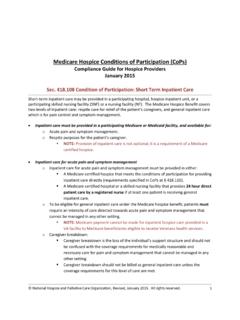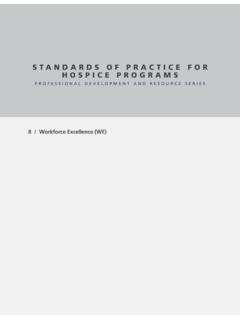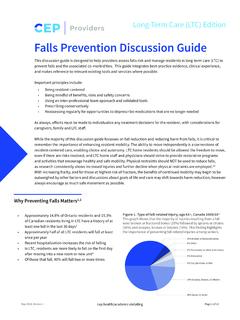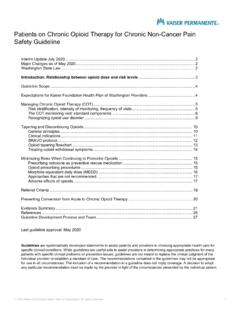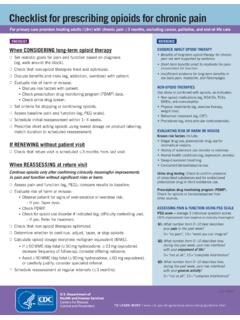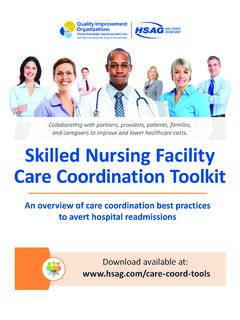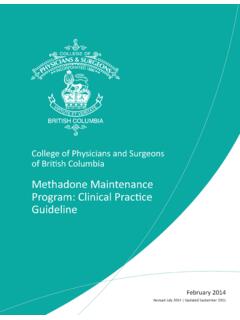Transcription of StandardS of Practice for HoSPice ProgramS - NHPCO
1 StandardS of Practice for H o sp i c e P r o g r a m s PROFESSIONAL DEVELOPMENT AND RESOURCE SERIES. 5 / Clinical Excellence and Safety (CES). 36. PROFESSIONAL DEVELOPMENT AND RESOURCE SERIES. 5 / Clinical Excellence and Safety (CES). PrincipleS. The HoSPice ensures clinical excellence and safety promotion through StandardS of Practice . The desired outcomes of HoSPice interventions are for patients to feel safe and comfortable throughout the dying process; and for patients and families to feel supported and have adequate information appropriate to their needs throughout the trajectory of the illness, the dying experience, and for the first year or longer after the death. HoSPice outcomes are individualized through a collaborative and reiterative process between the HoSPice interdisciplinary team and the patient/family/caregiver system. This process includes continuous assessment and identification of the goals, needs, strengths, and wishes of the patient and family/caregiver.
2 The HoSPice provides for the safety of all staff while promoting the development and maintenance of a safe environment for patients and families/caregivers served. Standard: CES 1: The comprehensive assessment performed by the HoSPice interdisciplinary team and the patient's goals for care serve as the basis for the development of the patient's plan of care. CES Initial information documenting the patient's terminal prognosis and principle diagnosis, as well as contributory and secondary diagnoses, is obtained and reviewed prior to admission to HoSPice services. CES The HoSPice nurse makes an initial assessment within 48 hours of the effective date of the patient's HoSPice election statement. CES The HoSPice interdisciplinary team, in consultation with the patient's attending physician, completes the comprehensive assessment within five calendar days of the effective date of the HoSPice election statement. CES The comprehensive assessment identifies the physical, psychosocial, emotional, spiritual, bereavement, and educational needs of the patient and family/caregiver that must be addressed in order to promote the patient's definition of wellbeing, comfort, and dignity throughout the dying process.
3 37. H O S P ICE V OL U NTEER P ROGRAM RESOURCE MANUAL. CES The comprehensive assessment includes: 1. The patient's immediate care needs on admission;. 2. Physical, psychosocial, emotional, spiritual, bereavement, and educational needs related to the terminal prognosis and principle diagnosis, plus related conditions;. 3. Patient and family/caregiver goals and preferences for care, learning styles, educational needs, and areas of concern;. 4. Patient and family/caregiver preferences for life sustaining treatments and hospitalization;. 5. Cognitive status evaluation;. 6. Condition(s)/diagnoses causing and contributing to the terminal prognosis;. 7. Current and previous palliation and management of the principle diagnosis and related condition(s);. 8. Complications, non-related conditions, risk factors, allergies, and intolerances;. 9. Functional status;. 10. Kidney and liver function status (when/if available, to ensure safe medication dosing).
4 11. Imminence of death;. 12. Chief complaint and prioritization of symptoms, including evaluation of symptom severity and burden;. 13. Medication profile review and reconciliation (including indication, effectiveness/ineffectiveness, side effects, dosage, drug-drug and drug-disease interactions, therapeutic duplication, need for laboratory monitoring, overall appropriateness based upon patient status, patient prognosis, and patient/family goals of care, risk/benefit analysis, adverse effects). Documented medications include prescription and over the counter medications, herbal remedies, and other alternative treatments related and unrelated to the patient's principle diagnosis and condition(s) that contribute to the terminal prognosis;. 14. Initial bereavement risk assessment of patient and family/caregiver, including social, spiritual, and cultural factors that may impact their ability to cope with the patient's death;. 15. Referrals to community or ancillary services.
5 16. Military history checklist (for Veterans); and 17. Changes that have occurred since the initial assessment, progress towards goals, reassessment, and response to care. CES The comprehensive assessment is updated as frequently as the condition of the patient requires but no less frequently than every 15 days and at the time of recertification. CES The comprehensive assessment includes data elements that allow for measurement of outcomes. These data elements are documented in a systematic and retrievable way for each patient and are used in individual care planning and documenting progress toward goals and outcomes, coordination of services and, in aggregate, for quality assessment/performance improvement. Practice Examples: The HoSPice uses the military history checklist as part of the comprehensive assessment for Veterans to evaluate the impact of their military experience, identify related conditions ( , PTSD), and determine if there are benefits to which the Veteran and surviving dependents may be entitled.
6 38. PROFESSIONAL DEVELOPMENT AND RESOURCE SERIES. The HoSPice has a mechanism to obtain past medical records from referral sources. The HoSPice includes assessment of common co-morbid conditions as part of the initial nursing assessment and review of all prescription, over-the-counter, and herbal medications. The assessment includes documentation of which conditions and medications are related to the terminal prognosis. The initial assessment includes documentation on the stated goals and wishes of the patient and family/caregiver. The initial assessment includes evidence of the discussion or confirmation of patient and family/caregiver's preferences regarding life sustaining treatments, including CPR and hospitalization. Standard: CES 2: The patient's goals for pain management are achieved. CES An initial pain assessment is completed for every patient upon admission to HoSPice , including severity, location, character, duration, frequency, what relieves and worsens pain, and effect on function and quality of life.
7 CES Ongoing pain assessments are performed and include the use of a self-report or observational pain rating scale appropriate to the patient's cognitive and functional status and general condition. CES Specialized pain assessment tools are available for various populations served ( , pediatric, nonverbal, non-English speaking, illiterate patients, and those unable to self-report). CES Procedures and protocols for pain assessment and management are developed and implemented with the involvement of a clinician(s) with pain assessment and management expertise. CES Patients and families/caregivers are educated about the importance of, barriers to, and methods of effective and safe pain management, including pain assessment and medication administration. CES Non-pharmacological interventions and adjuvant medications are included as pain management options as indicated. CES Common side effects of analgesics are anticipated and preventive measures are implemented.
8 CES Regular assessment of the current pain medication regimen and supply is made in order to quickly optimize pain control and avoid interruption or delay in ordering or obtaining any required analgesics. CES Patients who have opioids prescribed for pain or other symptom management also have a bowel regimen or documentation why a bowel regimen is contraindicated. 39. H O S P ICE V OL U NTEER P ROGRAM RESOURCE MANUAL. Practice Examples: Pain assessment is a distinct, easily identifiable part of the initial and subsequent assessments. Patient/family/caregiver instruction about the use and side effects of analgesic and adjuvant medications, non-pharmacological techniques ( , guided imagery, breathing techniques, energy consolidation), and expected responses to therapy is consistently documented in the patient record. Patients and families/caregivers are educated about the relationship between pain and psychosocial/emotional/spiritual factors that contribute to stress and end-of-life challenges.
9 Specific protocols/procedures are in place for reassessing patients who rate their pain greater than the identified level the patient desires. Non-pharmacologic therapies for pain management including, but not limited to, radiation therapy, complementary therapies, or surgical intervention are utilized as appropriate. The HoSPice has bowel regimen protocols for patients receiving opioids. Standard: CES 3: Symptoms other than pain are managed based on the patient's needs and response to treatments. CES Comprehensive assessments of all symptoms other than pain are routinely completed on every patient. CES Guidelines and/or protocols are developed for the assessment, screening, and management of common physical symptoms other than pain, including but not limited to: 1. Dyspnea and coughing;. 2. Nausea and vomiting;. 3. Anorexia and weight loss;. 4. Dehydration and dry eyes/nose/mouth;. 5. Anxiety;. 6. Depression;. 7. Confusion;. 8. Delirium;. 9.
10 Skin conditions, lesions, and wounds 10. Constipation and diarrhea;. 11. Restlessness and agitation;. 12. Sleep disorders;. 13. Mucositis;. 14. Edema and lymphedema, including ascites;. 15. Fever and infections;. 16. Seizures;. 40. PROFESSIONAL DEVELOPMENT AND RESOURCE SERIES. 17. Cachexia, weakness, and musculoskeletal disorders; and 18. Alterations in sensation and other neurological symptoms. CES The HoSPice nurse assesses the patient's nutritional status and implements appropriate nutritional interventions as desired by the patient and as deemed appropriate with regard to the patient's prognosis and medical history. If the patient's nutritional status needs are complex, a nutritionist of dietitian should assess the patient's needs. CES Education is provided to the patient and family/caregiver about the disease process and the palliation of the patient's symptoms. Practice Examples: The HoSPice develops educational tools to utilize in teaching patients and families/caregivers about the nutritional needs of the terminally ill including concerns about the patient not eating or drinking and considerations related to the provision of artificial feeding.


